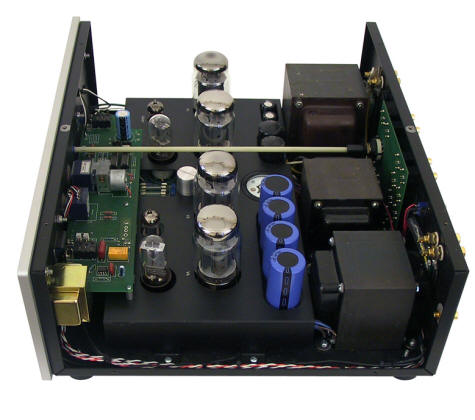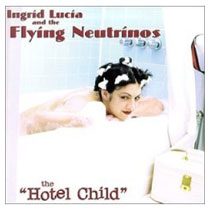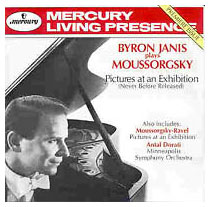
You are reading the older HTML site
Positive Feedback
ISSUE
25
may/june
rogue audio
Tempest II integrated
as reviewed by Steve Lefkowicz

|
STEVE LEFKOWICZ'S SYSTEM
LOUDSPEAKERS
ELECTRONICS
SOURCES
CABLES
ACCESSORIES
|
I have to start by saying it feels good to be back. For those who notice this sort of thing, this is my first written submission to PFO in about two and a half years. I'll write about why that is in a separate column sometime soon, but let's just say it had to do with freeway driving and a small physics demonstration using a mid size SUV going 65 MPH and a concrete barrier. The barrier won, and I still have some nerve damage in my left hand and arm, but at least the head has finally cleared up to where I can enjoy listening to music and evaluating equipment again. I also want to thank the two Daves (Clark and Robinson) for keeping me on the masthead during my recovery and allowing me to continue with PFO.
On to the Tempest…
For a first piece of equipment to welcome me back to these pages, the Tempest seemed like an ideal product. It sits firmly in the realm of gear that I like and am generally drawn to:
I like integrated amps.
I really like integrated tube amps.
I especially like KT-88 integrated tube amps.
I love reasonably priced KT-88 integrated tube amps.
That of course is all predicated on the idea that the reasonably priced KT-88 tube amp in question is a good reasonably priced KT-88 tube amp. The Rogue Audio Tempest II strikes me as an amp that I could come to love.
At around $2700, the Tempest II is fairly reasonably priced. It certainly costs more than other somewhat similarly spec'd amps from Antique Sounds Labs or Cayin, but it does seem much more substantial in its construction, and though similar in terms of number of tubes, it is rated at quite a bit more power than the lower priced amps. Also, the fact that it is made in the USA probably adds some to its cost. Regardless of that, is does seem reasonably and fairly priced for what you get.
First, I would like to explain why I like KT-88 amps. In this age of tube-o-philes constant search for ever more exotic lower powered tubes to make ever more expensive lower powered amplifiers (that cost ever so much more when the time comes to replace those fancy tubes), the KT-88 remains a veritable bargain amongst high quality tubes. With a little careful searching and some knowledge of who actually makes KT-88 tubes, you can buy high quality replacement KT-88s for very reasonable prices, under $100 for a matched pair of really good ones. Plus, with their higher power capability, KT-88 amps can be made to run normal everyday speakers. I use a 15-watt KT-88 amp (one KT-88 per channel) to drive Sound Dynamics 300ti speakers to great effect. Double up the KT-88 and you can get 40 to over 100 watts, depending on the circuit design. Rogue rates this amp at 90 WPC with two KT-8 per channel. I found this a little surprising, as the other amps I have tried in the past with two KT-88s per channel were always in the 40 to 50 WPC range. Rogue claims their tubes are not driven too hard, and should still have a very long life. I certainly had no problems over the months I had the Tempest at home.

KT-88s also do a great job at reproducing music. When done well, KT-88 amps can produce rich, complex harmonic structures, accompanied by powerful articulate bass. I think they handle music better than other somewhat similar tubes (like 6550, EL-34) but that is my opinion, I know many people who prefer their EL-34 tube amps.
This is not to say I do not also like low powered SET amps. Some of the very best systems I have ever heard were driven by flea-powered amps of three watts or less. It is just that for me, the low powered amp/high efficiency speaker combinations that impressed me so much were far enough out of my price range that they exist only in my fantasy world.
Getting more specifically to the Tempest II, as I mentioned earlier, I found much about the amp that I liked a great deal. It does all the things that I like about KT-88 amps, and in most areas, better than the ASL MG-SI15-DT amp that I usually use. After a few days to listen casually and make some minor adjustments, I started my evaluation with the SACD reissue of Blood Sweat and Tears second album (Columbia CS 63986); primarily the tracks "And When I Die" and "God Bless the Child". I found both of these songs were portrayed with all the richness, power, dynamics, and atmosphere that I could ask for. The dynamic presentation and overall bite of the brass section in "God Bless the Child" was exceptionally well done. The bass line was more forceful, rounded, and tuneful than what I usually get over my system (though not by as much as I had expected, given the Tempest's notably higher output). On the next track "Spinning Wheel", I felt I was getting "more cowbell" in the opening few bars.
 Moving next to the CD Hotel Child by
Ingrid Lucia and the Flying Neutrinos (I thank Francisco Duran for
turning me onto this CD every time I listen to it), I heard how well the
Tempest handled the pace and flow of the music. The first track of this
CD (Mr. Zoot Suit) is full of tight, fast-paced brass accompanying
Lucia's Billy Holiday-esque vocals, and very Gene Krupa influenced
drumming. This cut is one of my favorites for shows like CES and tells
me very quickly whether a system gets the basics right. With the Tempest
in my system, everything flowed right along, as it should. Even the drum
solo (one of the few I do not seem to mind, as I generally hate drum
solos) was spot on, with both the sound of the drums and how well
they are played portrayed convincingly.
Moving next to the CD Hotel Child by
Ingrid Lucia and the Flying Neutrinos (I thank Francisco Duran for
turning me onto this CD every time I listen to it), I heard how well the
Tempest handled the pace and flow of the music. The first track of this
CD (Mr. Zoot Suit) is full of tight, fast-paced brass accompanying
Lucia's Billy Holiday-esque vocals, and very Gene Krupa influenced
drumming. This cut is one of my favorites for shows like CES and tells
me very quickly whether a system gets the basics right. With the Tempest
in my system, everything flowed right along, as it should. Even the drum
solo (one of the few I do not seem to mind, as I generally hate drum
solos) was spot on, with both the sound of the drums and how well
they are played portrayed convincingly.
Tonally, this amp is very neutral, as far as you can go with that, at least in my system. That is, using the Tempest instead of any of my other amps did not alter the tonal balance in any musically significant way. There were no abnormalities to mess with either male or female vocals. Even with some of my favorite but difficult to make sound good singers like Maddy Prior, Johnny Cash, Katherine Whalen, or Colin Meloy (of The Decemberists), the Tempest had no trouble at all. Maddy never sounded like a rooster at dawn (my wife's description of her), Cash never sounded like he was standing in a bathroom, Whalen didn't sound like Melanie Griffith, and Meloy, well, he still sounded whiney, but at least it was a good whiney.
 Typical of well executed KT-88 amps, the
Tempest did a fine job with hanging instruments out in the listening
room and freeing them up from the speakers. There was a good sense of
palpability and airiness to the music. This amp certainly satisfied my
needs concerning imaging and soundstaging. I especially appreciated how
the size and scale of different instruments were produced. Trombones
sounded both powerful and big, grand pianos sound large and grandiose
(for example, Byron Janis playing Moussorgsky, Pictures at an
Exhibition, Mercury Living Presence 434 346-2 CD). Bass (and bass
drums) had the weight and power they needed to sound right.
Typical of well executed KT-88 amps, the
Tempest did a fine job with hanging instruments out in the listening
room and freeing them up from the speakers. There was a good sense of
palpability and airiness to the music. This amp certainly satisfied my
needs concerning imaging and soundstaging. I especially appreciated how
the size and scale of different instruments were produced. Trombones
sounded both powerful and big, grand pianos sound large and grandiose
(for example, Byron Janis playing Moussorgsky, Pictures at an
Exhibition, Mercury Living Presence 434 346-2 CD). Bass (and bass
drums) had the weight and power they needed to sound right.
One point I think stands out with amp. This amp is clearly a tube amp, sounds like a tube amp, does all the tube amp things that people who like tube amps want. However, it sounds thoroughly modern in that there is no "warmth" about it (whatever that means, but tube amps are always being accused of sounding "warm"). It does not roll off the top end, fatten up the bottom end or obscure details, or do any of the negative things that tube amps can do if poorly designed. From that standpoint, this amp might help non-tube-amp people to understand why tubes are still so prevalent in high quality audio today.
Are there any things about the Tempest that I do not like, or that I can criticize? Sure no product is perfect, and you just have to weigh the imperfections with your tastes and biases to see how significant they are and if you can live with them. For me, the Tempest is a little less transparent that my Antique Sounds Labs amp. Maybe it is the more complex design; maybe it is the doubling up of the tubes (other amps I have had here that used two KT-88s in push-pull or ultralinear configurations were also a little less transparent than the ASL, which is a remarkably transparent amp). It is not a big difference or a big deal, but something to note. Things may be different in your system of course.
Also, the amp is big and heavy. That is probably not an issue for most people, but I have long term back problems and lifting items over 50 pounds is a little difficult for me. Also, it did not fit on any of my shelves. So I had to improvise, and came up with a good solution using particleboard and Bright Star IsoNodes.
All told, the Tempest II is an excellent amp, comes highly recommended for those of you looking for a high quality integrated amp (whether you are looking for tubes specifically or not). There is a lot of competition in the price range, but I would suggest you find a Rogue dealer and check it out. Steve Lefkowicz
Tempest II integrated
Retail: $2695
Specifications
-
Output power: 90 WPC minimum
-
THD: <0.1% typ., <1% at rated power
-
Frequency response: 20Hz - 20KHz at peak output, 10Hz - 100KHz at 10 watts
-
Input sensitivity: 1.0V RMS
-
Dimensions: 18" W x 15¾" D x 7" H
-
Weight: 60 lbs
Rogue Audio
web address: www.rogueaudio.com
